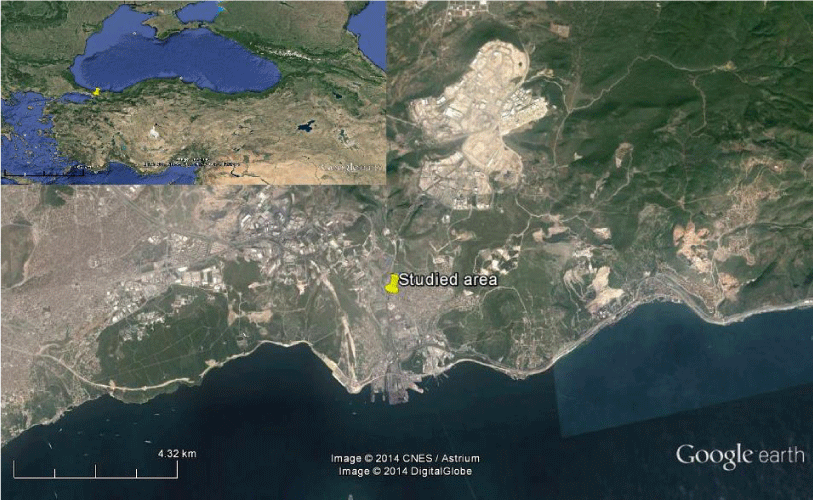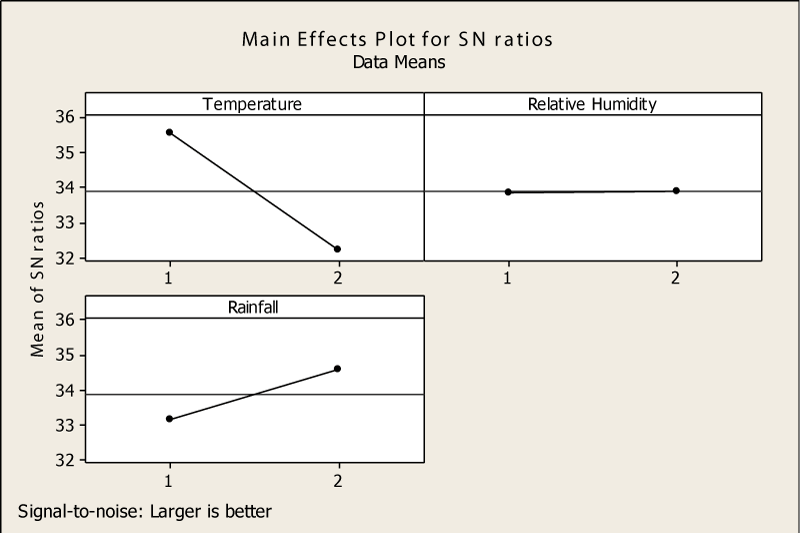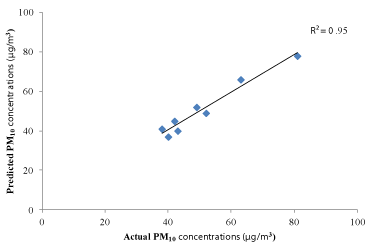Journal of Civil Engineering and Environmental Sciences
Impacts of Meteorological Factors on Particulate Pollution: Design of Optimization Procedure
Utkan Özdemir*
Cite this as
Özdemir U (2016) Impacts of Meteorological Factors on Particulate Pollution: Design of Optimization Procedure. J Civil Eng Environ Sci 2(1): 030-033. DOI: 10.17352/2455-488X.000011In this study, Taguchi L8 orthogonal array design was applied to determine the most polluted meteorological conditions in Kocaeli. Meteorological factors were decided as temperature, relative humidity and rainfall in two different levels. Larger is better function was applied for calculation of signal-to-noise ratios. The impact ratios of meteorological factors were also determined by using Taguchi model. PM10 concentrations were predicted by the model. Results of the model showed that predicted and obtained concentrations were closer to each other. These calculations and results show the success of Taguchi model in this study.
Introduction
Particulate matter (PM) is one of the major air pollutants in urbanization region [1]. Effects of PM pollution on human and environmental systems have been discussed by many of scientists. Particulates with aerodynamic diameters <10µm (PM10) and <2.5µm (PM2.5) causes lung cancer, asthma, morbidity and mortality [2,3]. So, air pollution control and monitoring are very important for saving ecological system.
Relationship between aerosol concentration and meteorological variables should be investigated for better control and monitoring applications. Aerosol concentrations are controlled by atmospheric mixing, chemical transformation, emission etc. [4]. Although this presence of concentration-meteorology system is real, the understanding of the connection between meteorological factors (relative humidity, temperature, wind, rainfall etc.) with particulate matter is not clear [5]. Because in lots of countries, researchers have limited number of studies about different aerosol fractions for a long time to characterization of relationship between meteorological factors and air pollution [4-6].
In last decades, some statistical and optimization tools such as multiple linear regression analyses [7], artificial neural networks [7,8], Box-Behnken designs [9], Taguchi orthogonal arrays [10-12] etc. are used for investigation of pollution in different environments. Taguchi bases on statistical design systems and successfully applied in lots of scientific disciplines. Compared to other statistical methods, Taguchi model is simple, effective and innovator for investigation of environmental risks [13,14]. Harmful effects of multiple factors on environment can be investigated by this model. On the other hand, the influence of individual factors is more important for success of this model [10].
In line with the above information, statistical and optimization model studies that can explain the connection between pollutant concentration and meteorological factors should be increased. Taguchi generally require less data and researchers can make successful comments with orthogonal array designs. So, this method will find a place in the field of the effects of meteorological factors on distribution of air pollutants (especially particulate matter). In this study, the impacts of three different meteorological factors (temperature, relative humidity, rainfall) on the average concentration of particulate matter (PM10) will be examined by Taguchi’s L8 orthogonal arrays. Air pollution levels of PM10 were also predicted by using the model. For this study, air monitoring data (average pollutant levels and meteorological factors) obtained from Ministry of Environment and Urban Planning in industrial areas of Kocaeli.
Materials and Methods
Study area
Kocaeli is one of the important and crowded cities in Turkey. Lots of heavy industrial plants have been located here. On the other hand, it has quite an intense traffic network. So, air pollution is the major environmental problem in this city.
In this study, PM10 and meteorological data sets obtained from the station of Ministry of Environment and Urban Planning. The study area is located between latitude of 40° 46’ North and 29° 31’ East (Figure 1).
Taguchi procedure
Selection of the control factors is the most important step in Taguchi applications. Temperature, relative humidity and rainfall with two levels were selected as control factors in this model study (Table 1).
In Taguchi model studies, the variability of factors expressed by signal-to-noise ratios ( ). One of the functions must be chosen as “smaller is better”, “nominal is better” and “larger is better” [15]. Larger is better characteristics was chosen for this work. Because this study was designed to investigate the meteorological factors which cause maximum PM10 concentration in Kocaeli. The ratio for the larger is better function was calculated as:
where yi is the observed PM10 concentrations and n is the number of repetitions.
L8 orthogonal array was chosen for this study. Table 2 shows L8 orthogonal array of meteorological factors onto PM10. All calculations and applications of this study were hosted in Minitab 16 software package and Microsoft Excel 2007.Results and Discussions
In this study, the general goal was to determine the impacts of some meteorological factors such as temperature, relative humidity and rainfall onto PM10 pollution in an industrial area of Kocaeli. Taguchi method was designed as L8 orthogonal array for this work.
In Taguchi applications, calculating of ratios are the most important stage for evaluate the meteorological and PM10 data sets clearly. ratios show the consistency between control factors (temperature, relative humidity and rainfall) and response data (PM10). Larger is better type of ratios were calculated according to Eq. (1) and the results were given in Table 3.
As seen from Table 3, obtained data sets providing the highest signal-to-noise ratio are as 1-2-2. This code (1-2-2) indicates that PM10 concentration became higher in winter seasons conditions (temperature <15 ºC, relative humidity > %65 and rainfall > 55 mm). PM10 concentrations in winter are higher in Kocaeli because of warming-induced. This shows models better reality capacities of Taguchi models. Minitab graph of were also given in Figure 2.
Taguchi model shows that temperature is the most important meteorological factors on PM10 pollution in Kocaeli. The impact ratio of temperature was calculated as 69.40%. Whereas impacts of temperature were higher, relative humidity was the less effective factor in this model study. Impact ratios of the meteorological factors were presented in Table 4.
Taguchi statistical optimization model has also a prediction capacity. PM10 concentrations in Kocaeli were also predicted by this model. Predicted pollutant concentrations versus obtained concentrations are given in Figure 3.
Figure 3 shows that higher correlation was obtained between predicted and real PM10 concentrations (R2= 0.95). So, Taguchi model was successful in prediction of pollutant concentration of Kocaeli.
Conclusion
Taguchi’s L8 orthogonal array design was applied in this study for determine the meteorological conditions which have the most intense PM10 concentrations in Kocaeli. Signal-to-noise ratios showed that temperature was the most important factor in particulate pollution for this study. It has 69.40% impact ratio on PM10 concentration. This study demonstrates the seasons of area are very remarkable in particulate concentration. Because Taguchi data indicates that PM10 concentration became higher in winter seasons conditions (temperature <15 ºC, relative humidity > %65 and rainfall > 55 mm). On the other hand, higher correlation (R2=0.95) was determined the strong relationship between predicted and actual PM10 concentrations.
- McKendry IG (2000) PM10 levels in the Lower Fraser Valley, British Columbia, Canada: an overview of spatiotemporal variations and meteorological controls. J Air Waste Ma 50: 443-452. Link: https://goo.gl/6jW0Ro
- Brandt C, Kunde R, Dobmeier B, Schnelle-Kreis J, Orasche J, et al. (2011) Ambient PM10 concentrations from wood combustion-emission modeling and dispersion calculation for the city area of Augsburg, Germany. Atmos Environ 45: 3466-3474. Link: https://goo.gl/ZTy1xn
- Akyüz M, Cabuk H (2009) Meteorological variations of PM2.5/PM10 concentrations and particle-associated polycyclic aromatic hydrocarbons in the atmospheric environment of Zonguldak, Turkey. J Hazard Mater 170: 13-21. Link: https://goo.gl/035UqZ
- Choi YS, Ho CH, Cheni D, Noh YH, Song CK (2008) Spectral analysis of weekly variation in PM10 mass concentration and meteorological conditions over China. Atmos Environ 42; 655-666. Link: https://goo.gl/muZV4d
- Pateraki St, Asimakopoulos DN, Flocas HA, Maggos Th, Vasilakos Ch (2012) The role of meteorology on different sized aerosol fractions (PM10, PM2.5, PM2.5–10). Sci Total Environ 419: 124-135. Link: https://goo.gl/s9J12K
- Lee S, Ho CH, Choi YS (2011) High-PM10 concentration episodes in Seoul, Korea: background sources and related meteorological conditions. Atmos Environ 45: 7240-7247. Link: https://goo.gl/lOYkTD
- Özdemir U, Özbay B, Veli S, Zor S (2011) Modeling adsorption of sodium dodecyl benzene sulfonate (SDBS) onto polyaniline (PANI) by using multi linear regression and artificial neural networks. Chem Eng J 178: 183-190. Link: https://goo.gl/vtbUKp
- Yetilmezsoy, K., Demirel, S., (2008) Artificial neural network (ANN) approach for modeling of Pb(II) adsorption from aqueous solution by Antep pistachio (Pistacia Vera L.) shells. J Hazard Mater 153: 1288-1300. Link: https://goo.gl/exwJu2
- Gengec E, Özdemir U, Özbay B, Özbay İ, Veli S (2013) Optimizing dye adsorption onto a waste-derived (modified charcoal ash) adsorbent using Box–Behnken and Central Composite Design procedures. Water Air Soil Poll 224: 1751. Link: https://goo.gl/VcXwCJ
- Al G, Özdemir U, Aksoy Ö (2013) Cytotoxic effects of Reactive Blue 33 on Allium cepa determined using Taguchi's L8 orthogonal array. Ecotox Environ Safe 98: 36-40. Link: https://goo.gl/pm7Alv
- Sadeghi SH, Moosavi V, Karimi A, Behnia N (2012) Soil erosion assessment and prioritization of affecting factors at plot scale using the Taguchi method. J Hydrol 448-449: 174-180. Link: https://goo.gl/pww4Ol
- Mohan SV, Mouli PC (2008) Assessment of aerosol (PM10) and trace elemental interactions by Taguchi experimental design approach. Ecotox Environ Safe 69: 562-567. Link: https://goo.gl/w1Y0iS
- Yusoff N, Ramasamy M, Yusup S (2011) Taguchi’s parametric design approach for the selection of optimization variables in a refrigerated gas plant. Chem Eng Res Des 89: 665-675. Link: https://goo.gl/IN8BDo
- Zirehpour A, Rahimpour A, Jahanshahi M, Peyravi M (2014) Mixed matrix membrane application for olive oil wastewater treatment: process optimization based on Taguchi design method. J Environ Manage 132: 113-120. Link: https://goo.gl/kpv8sn
- Zolgharnein J, Asanjarani N, Shariatmanesh T (2013) Taguchi L16 orthogonal array optimization for Cd (II) removal using Carpinus betulus tree leaves: Adsorption characterization. Int Biodeter Biodegr 85: 66-77. Link: https://goo.gl/QZGRkp
Article Alerts
Subscribe to our articles alerts and stay tuned.
 This work is licensed under a Creative Commons Attribution 4.0 International License.
This work is licensed under a Creative Commons Attribution 4.0 International License.




 Save to Mendeley
Save to Mendeley
